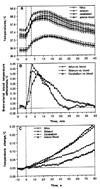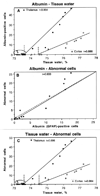Brain temperature homeostasis: physiological fluctuations and pathological shifts
- PMID: 20036808
- PMCID: PMC3149793
- DOI: 10.2741/3608
Brain temperature homeostasis: physiological fluctuations and pathological shifts
Abstract
Brain temperature is a physiological parameter, reflecting the balance between metabolism-related intra-brain heat production and heat loss by cerebral circulation to the rest of the body and then to the external environment. First, we present data on brain temperature fluctuations occurring under physiological and behavioral conditions and discuss their mechanisms. Since most processes governing neural activity are temperature-dependent, we consider how naturally occurring temperature fluctuations could affect neural activity and neural functions. We also consider psychomotor stimulants and show that their hyperthermic effects are state-dependent and modulated by environmental conditions. Since high temperature could irreversibly damage neural cells and worsen various pathological processes, we consider the situations associated with pathological brain hyperthermia and evaluate its role in acute perturbations of brain functions, neurotoxicity, and neurodegeneration. We also discuss the limitations in consideration of brain temperature within the frameworks of physiological regulation and homeostasis. While different adaptive mechanisms could, within some limits, compensate for altered intra-brain heat balance, these mechanisms could fail in real-life situations, resulting in life-threatening health complications.
Figures







Similar articles
-
Brain temperature: from physiology and pharmacology to neuropathology.Handb Clin Neurol. 2018;157:483-504. doi: 10.1016/B978-0-444-64074-1.00030-6. Handb Clin Neurol. 2018. PMID: 30459022 Review.
-
MDMA, Methylone, and MDPV: Drug-Induced Brain Hyperthermia and Its Modulation by Activity State and Environment.Curr Top Behav Neurosci. 2017;32:183-207. doi: 10.1007/7854_2016_35. Curr Top Behav Neurosci. 2017. PMID: 27677782 Free PMC article.
-
The hidden side of drug action: brain temperature changes induced by neuroactive drugs.Psychopharmacology (Berl). 2013 Feb;225(4):765-80. doi: 10.1007/s00213-012-2957-9. Epub 2012 Dec 29. Psychopharmacology (Berl). 2013. PMID: 23274506 Free PMC article. Review.
-
Brain hyperthermia as physiological and pathological phenomena.Brain Res Brain Res Rev. 2005 Dec 1;50(1):27-56. doi: 10.1016/j.brainresrev.2005.04.001. Brain Res Brain Res Rev. 2005. PMID: 15890410 Review.
-
Environmental conditions modulate neurotoxic effects of psychomotor stimulant drugs of abuse.Int Rev Neurobiol. 2012;102:147-71. doi: 10.1016/B978-0-12-386986-9.00006-5. Int Rev Neurobiol. 2012. PMID: 22748829 Free PMC article. Review.
Cited by
-
Alteration of brain temperature and systemic inflammation in Parkinson's disease.Neurol Sci. 2020 May;41(5):1267-1276. doi: 10.1007/s10072-019-04217-3. Epub 2020 Jan 10. Neurol Sci. 2020. PMID: 31925613 Free PMC article.
-
A comparison of three different methods of eliciting rapid activity-dependent synaptic plasticity at the Drosophila NMJ.PLoS One. 2021 Nov 30;16(11):e0260553. doi: 10.1371/journal.pone.0260553. eCollection 2021. PLoS One. 2021. PMID: 34847197 Free PMC article.
-
An exploratory study of brain temperature and choline abnormalities in temporal lobe epilepsy patients with depressive symptoms.Epilepsia Open. 2023 Dec;8(4):1541-1555. doi: 10.1002/epi4.12838. Epub 2023 Nov 1. Epilepsia Open. 2023. PMID: 37813409 Free PMC article.
-
Phasic and tonic fluctuations in brain, muscle, and skin temperatures during motivated drinking behavior in rats: physiological correlates of motivation and reward.Brain Res. 2010 Jan 15;1310:87-102. doi: 10.1016/j.brainres.2009.11.036. Epub 2009 Nov 22. Brain Res. 2010. PMID: 19932691 Free PMC article.
-
Physiological fluctuations in brain temperature as a factor affecting electrochemical evaluations of extracellular glutamate and glucose in behavioral experiments.ACS Chem Neurosci. 2013 May 15;4(5):652-65. doi: 10.1021/cn300232m. Epub 2013 Mar 14. ACS Chem Neurosci. 2013. PMID: 23448428 Free PMC article. Review.
References
-
- Schmidt-Nielsen K. Adaptation and Environment. 5th Edition. Cambridge: Cambridge University Press; 1997. Animal Physiology.
-
- James W. Briefer Course. New York: Henry Holt; 1892. Psychology. 1892.
-
- Abrams R, Hammel HT. Hypothalamic temperature in unanesthetized albino rats during feeding and sleeping. Am. J. Physiol. 1964;206:641–646. - PubMed
-
- Delgado JMR, Hanai T. Intracerebral temperatures in free-moving cats. Am. J. Physiol. 1966;211:755–769. - PubMed
-
- Feitelberg S, Lampl H. Warmetonung der Grosshirnrinde bei Erregung und Ruhe Functionshemmung. Arch. Exp. Path. Pharmak. 1935;177:726–736. (in German)
Publication types
MeSH terms
Substances
Grants and funding
LinkOut - more resources
Full Text Sources
Medical

